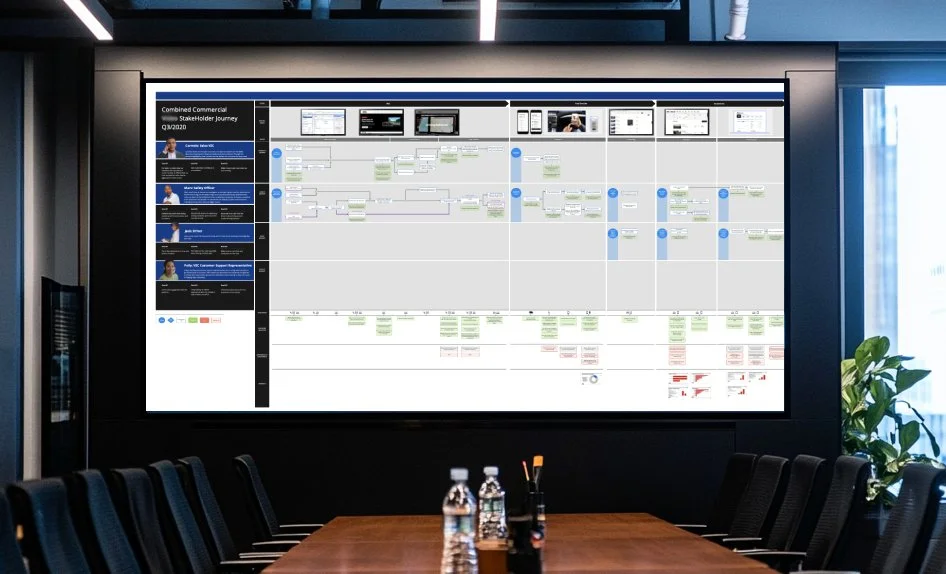Product &
Service Improvement
Fleet management systems
The fleet management client had a product portfolio of five products; three were original, profitable Saas applications, and two were new product lines struggling to gain and retain custome
The new product lines were Service Management and the Dash Cam Application.
The Services Management tracked service deliveries throughout the day, leveraging artificial intelligence to monitor traffic and estimate potential delays.
The Dash Cam Application used artificial intelligence to assess the risk of potential accidents using live recordings from the truck dashcams.

The Business Challenge
Both products faced declining sales and renewals. To turn them around, we needed a customer-centric strategy focused on understanding why customers weren’t buying or renewing.
My Role
I led a product strategy initiative that consolidated customer and competitor insights, providing the PM and executive team with data-driven recommendations for survival and growth.
My background with global advertising giants and Pragmatic Marketing Certification (PMC III) helped me drive initiatives using proven frameworks.
Research Initiatives
My approach consisted of four key steps.
Mapping an End-to-End Service Blueprint
Benchmarking Product Performance
Conducting a Competitive Analysis and Heuristic Evaluation
Synthesizing the Product Design Strategy
Each step would be delivered by a cross-functional team. While I asked my team to deliver each step, I also asked the product team to participate in workshops to gain their support and leverage their knowledge.
From the beginning, product management was sceptical of a data-driven approach to product development.
Mural workshop to consolidate all the internal stakeholders insights to create a mental model
Researching the SERVICE BLUEPRINT
Since the design team lacked experience with service blueprints and end-to-end journeys, I led this initiative, assigning smaller tasks to designers and researchers.
Created the service blueprint covering the end-to-end customer product experience
Approach
Cross-Team Discovery
I led workshops with product owners to map user journeys for four key personas, then expanded research through interviews with sales and support teams. These uncovered why new and potential customers were disengaging—often ignoring contracts or turning to competitors.
Data Workaround
When requests for user interviews were declined, I teamed up with researchers and a data scientist to mine historical feedback stored in Excel and Word files. Using a Python script, we uncovered patterns and automated insights that informed and enriched our service blueprint despite the lack of fresh user input.
Research Synthesis
By combining workshop findings, interview analysis, and past research, I mapped a comprehensive service blueprint that highlighted critical customer pain points and proposed targeted solutions.
The blueprint captured the full end-to-end experience—from sales and hardware delivery to installation, app launch, and customer support, providing a clear and actionable view of the customer journey.
Business Impact
When I presented the blueprint to the Chief Technology Officer, VP of Product, and Design Director, it led to a major shift in stakeholder understanding.
They recognised gaps they hadn’t seen before and immediately saw new opportunities to improve both product and service delivery.
My approach not only uncovered the root causes behind customer frustration but also directly influenced leadership's strategic priorities, building stronger alignment between product, design, and customer experience teams.

BENCHMARKING THE DASH CAM Mobile Experience
The other aspect of the product design strategy was to understand how well our application performed compared to our competitors.
This knowledge would help us identify which feature sets need improvement to outperform our competition.
Approach
Hypothesis-Driven Start
With research requests blocked, the team, researchers, designers, and product owners, identified core user tasks using a hypothesis-driven approach instead of Jobs-to-Be-Done research.
Testing for Insights
Despite the limitations, this gave us a solid data foundation for UX improvements. We ran A/B tests using our prototypes and competitor mockups, guided by a researcher-developed testing protocol and deployed via usertesting.com.
Business Impact
The results provided valuable insights into the user experience, highlighting challenges and gaps in task completion compared to competitors.
It was the first time designers evaluated an experience from end to end, broadening their perspective beyond isolated features. We also integrated the findings into our product design strategy deck, showing where competitors outperformed us in ease of use.
Screenshot of the competitive analysis.
COMPETITIVE ANALYSIS & HEURISTIC EVALUATION
The senior designer on the innovation team, one of my team members, led and conducted the competitive analysis and heuristic evaluation of the Dash Cam.
Since he had just done this process once before, he was very excited to practice his skills and work on the analysis.
Mentorship
I guided a senior designer through conducting a competitive analysis—defining key parameters, sourcing hard-to-find B2B application data, and running the evaluation. I also showed how this informed a heuristic review of competitor features.
After my initial support, he completed both analyses, which we used to present insights to the product team on market positioning, feature sets, and our product’s relative performance.

Developing the PRODUCT STRATEGY
Final Deliverable
I prepared the final Design Product Strategy Deck for the annual roadmap planning for the following year.
For the presentation, I synthesized the findings of the service blueprint, competitive analysis, heuristics evaluation, and A/B testing results.
The deck outlined the challenges faced by the customer, sales, and support teams within the end-to-end experience of both product lines.
Product Roadmap Impact
The product design strategy included items that customers and teams identified as critical, which significantly impact customer satisfaction and should be considered for an initiative in the product roadmap.
The deck also included competitive insights to help the PM make data-driven decisions on shaping the product strategy for the coming years.
Recognized Leadership
I presented the design team’s work to the VP of Product, the Chief Technology Officer, the Head of Design, the Executive Sponsors, and the PM for both products.
After the meeting, the Head of Design, pulled me aside and told me that the executive team was impressed with my team’s work.
The executive sponsor applauded me for coming into my own in the role of leading the product design strategy on the project.


